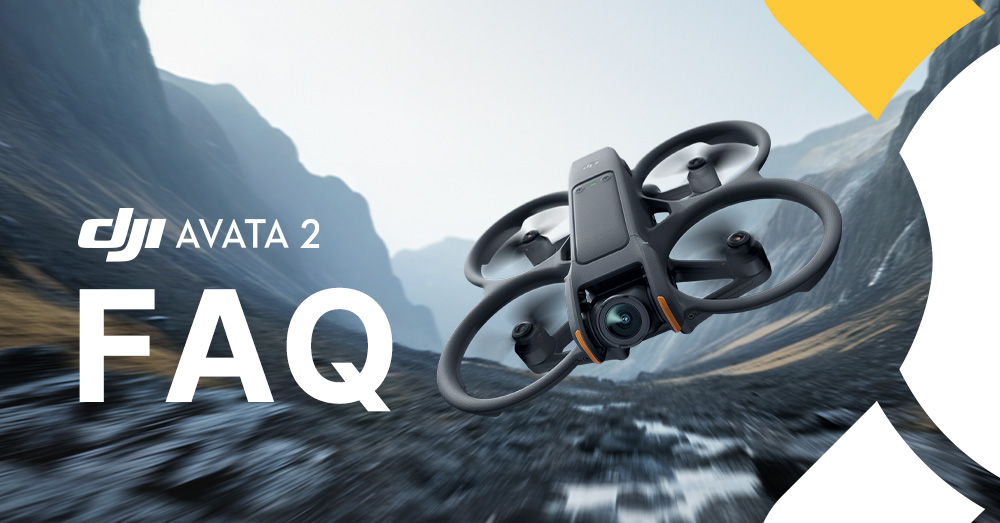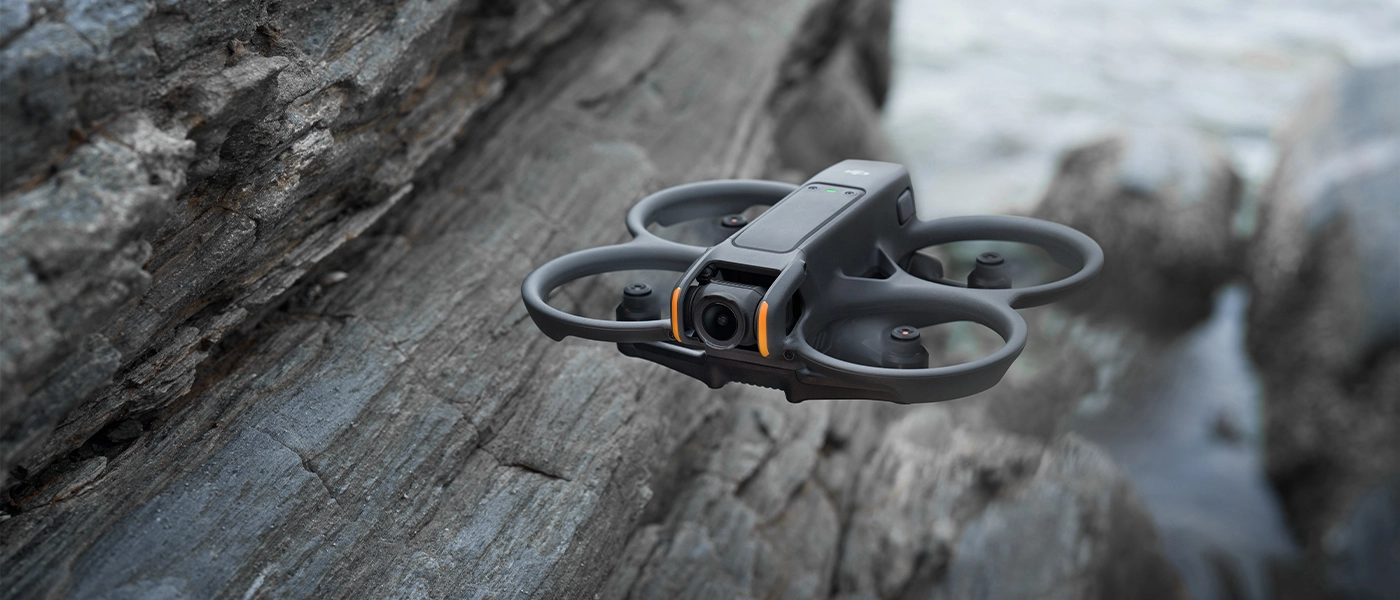DJI Avata 2 - FAQ


What improvements does DJI Avata 2 have over DJI Avata?
DJI Avata 2 offers comprehensive improvements in various aspects, such as, for example, in-flight volume, visual perception system, image quality, video transmission, battery life and smart features. Specific improvements include:
- The volume level has been reduced to about 81 dB, providing a more pleasant listening experience.
- Based on the integrated design of the propeller guard, the drone is equipped with an improved fisheye optical system that enables both downward and backward sensing for more precise flight positioning.
- The drone is equipped with a new image processing platform and advanced stabilization algorithms, allowing it to record in 4K/60FPS. In addition, the optional 10-bit D-Log M color mode allows you to significantly increase the dynamic range of video.
- DJI Avata 2 supports the brand-new DJI O4 HD transmission system, which allows video to be transmitted over distances of up to 10 km with a maximum bitrate of 60 Mbps.
- The maximum flight time has been extended to 23 minutes, and the drone supports PD fast charging. In addition, the charging hub designed for it offers a power accumulation function, greatly reducing users' battery concerns.
- New Easy ACRO feature provides a more immersive flight experience with motion controls.
*Measured in an outdoor environment free of obstructions and interference. The above figures show the farthest communication range for one-way flights with no return according to the CE standard. Always pay attention to RTH notifications displayed on the goggle screen during flight.
**Measured during forward flight at 21.6 km/h, in a windless environment, at sea level, with camera parameters set to 1080p/30fps, with video mode turned off and from 100% battery level to 0%. The information provided here is for reference only. Always pay attention to the notifications displayed on the goggle screen during the flight.
What sets DJI Avata 2 apart from other consumer drones DJI?
DJI Avata is an FPV (first-person view) drone that requires the DJI Goggles series and the DJI RC Motion or DJI FPV Remote Controller series to operate. This immersive flight experience gives you the joy of moving freely in space. Unlike other consumer drones, DJI Avata 2 offers unique camera angles and fun, entertaining controls.
Unique recording perspective: with an integrated propeller guard designed with safety in mind DJI Avata 2 can fly at low altitudes, indoors and in wooded areas, and even under bridges and close to objects. This allows you to shoot videos from unique angles and perspectives.
Interesting control experience: once the drone is paired with the DJI RC Motion 3 controller, users can quickly learn to fly - without complicated and extensive instructions. There is a special mode for beginners to ensure safety, as well as an EASY Acro function to enhance the pleasure of flight. What's more, in combination with the DJI FPV Remote Controller 3, users can use Manual mode (M mode), which gives total freedom to fly in the skies.
Did DJI Avata 2 get C1 class in Europe?
Yes, the level of certification that the drone DJI Avata 2 has received is C1, issued by the European Union Agency for the Evaluation of Medicinal Products. Air Safety Authority (EASA).
What goggles are compatible with DJI Avata 2?
Drone DJI Avata 2 is compatible with DJI Goggles 3. In addition, an update came out with 03/06/2024 that makes Avata 2 compatible with DJI Goggles 2 and DJI Goggles Integra.
What control instruments are compatible with DJI Avata 2?
DJI Avata 2 supports cameras such as DJI RC Motion 3 and DJI FPV Remote Controller 3. In addition, as of 03/06/2024, the drone is also compatible with DJI RC Motion 2 and DJI FPV Remote Controller 2.
What file storage options does DJI Avata 2 offer?
DJI Avata 2 offers 46 GB of internal memory and supports SD cards.
Note: the recording speed of the drone's built-in memory may decrease after prolonged use, potentially degrading recording quality. Transfer data according to the instructions displayed on the goggle screen, and then format the internal memory to ensure smooth video recording in subsequent applications.
Does DJI Avata 2 support obstacle avoidance?
No, in n (Normal) and S (Sport) mode DJI Avata 2 supports lower and rear vision positioning to enhance flight safety.
Can you use the drone DJI Avata 2 without goggles?
No, without goggles using the drone is not possible.
What advanced control options does DJI Avata 2 support?
DJI Avata 2 allows flying in M (Manual) mode.*
*Controller required DJI FPV Remote Controller 3.
What improvements have been made to the camera module DJI Avata 2 compared to DJI Avata?
- The photosensitive area of the sensor has been increased, leading to higher sensitivity and much better filming results, making the drone DJI Avata 2 more suitable for low-light recording.
- The dynamic range of the sensor has been improved, making the drone DJI Avata 2 better suited for capturing scenes with a high dynamic range.
- EIS electronic image stabilization has been improved. When using DJI RC Motion 3, the RockSteady function is enabled at normal filming angles and when recording video at 60FPS, resulting in smoother and more stable footage.
- DJI Avata 2 supports 10-bit D-Log M color mode, giving users more flexibility in the video post-production process.
Does DJI Avata 2 support electronic camera stabilization?
Yes, DJI Avata 2 offers three modes to choose from: RockSteady, HorizonSteady and Off.
*When stabilization is disabled, footage recorded in wide-angle mode supports offline Gyroflow stabilization.
The default stabilization mode for DJI Avata 2 is RockSteady. Users can adjust the settings by going to Settings > Camera > EIS in the goggle menu.
Does DJI Avata 2 support offline Gyroflow stabilization?
Yes, inynstall the electronic image stabilization (EIS) and set the recording to Wide mode. The footage captured in this way will support Gyroflow's offline stabilization.
How to transfer files from DJI Avata 2 to your phone or computer?
Transferring files to your phone:
DJI Avata 2 allows Wi-Fi transfer via the DJI Fly app - in this situation the download speed is up to 30 MB/second.*
Launch the drone, turn on the DJI Fly app and use the QuickTransfer function by following the instructions.
For the best possible transfer, keep your drone and phone within 2 meters of each other without any obstructions.
Transferring files to a computer:
Connect the turned-off drone to the computer with a USB cable.
If you are using a memory card, insert it directly into the computer.
*Measurements were conducted under laboratory conditions, with little interference, in countries/regions supporting 2.4 GHz and 5.8 GHz frequencies. Download speeds may vary depending on actual conditions.
What improvements does the O4 video transmission supported by the drone DJI Avata 2 offer over the O3 video transmission supported by DJI Avata?
- New hardware solutions are used. The number of drone antennas has been increased from two (2T2R) to four (2T4R).
- A new bandwidth is available, so the maximum range of live high-definition transmission has been increased to 10 km with a communication bandwidth of 60 MHz.*
- The maximum bitrate of transmission has been increased to 60 Mbps.
- When paired with DJI Goggles 3, the latency for 1080p/100FPS live streaming is only about 24ms, and 40ms for 1080p/60FPS streaming.
*Measured in an outdoor environment free of obstructions and interference. The above figures show the farthest communication range for one-way flights with no return according to CE standards and are for reference only. Always pay attention to RTH notifications displayed on the goggle screen during flight.
How to share live video from DJI Avata 2 during flight?
Are there any restrictions on the number of devices?
There are three ways to share live broadcasts:
- Wireless sharing via Wi-Fi: you can enable screen sharing from DJI Goggles 3 to your phone via Wi-Fi in the Goggles menu. A mobile device can be connected to DJI Goggles 3 via Wi-Fi, and the DJI Fly app will display live video from the drone. Wireless sharing function supports connection to only one mobile device.*
- Wired sharing: you can connect your mobile device to DJI Goggles 3 using a data cable and cable with OTG adapter. When you do this, the DJI Fly app will display a live view from the drone. Wired sharing also supports connection to only one device.
- Audience mode: you can enable the broadcast function in the Goggles menu, allowing many DJI Goggles 3 to tune into the broadcast channel. This will cause the live broadcast to be displayed on multiple channels. There is no upper limit on the number DJI of Goggles 3 that can connect in Audience mode.
Note: whether goggles or a mobile device, only one type of connection is supported at any given time.
*In some countries and regions the use of the frequency band 5.1 GHz , 5.8 GHz or both is not allowed. In selected countries and regions, the 5.1 GHz frequency is only allowed for indoor use. If the 5.1 GHz / 5.8 GHz frequency band is unavailable (e.g., in Japan), screen sharing to a smartphone via Wi-Fi is not possible. Wired connection is recommended for screen sharing. Check and follow local regulations before flying.
Does DJI Avata 2 support RTH?
Yes, supports Smart RTH, Low Battery RTH and Failsafe RTH.
Does DJI Avata 2 support Turtle mode?
Yes, Turtle mode is supported by DJI Avate 2.
Can DJI Avata 2 fly indoors?
Yes, you can fly the drone DJI Avata 2 indoors.
Does DJI Avata 2 support Find My Drone function?
Yes. In the goggle menu, go to Settings > Safety > Find My Drone to view the video recorded 30 seconds before you lost your drone to help you locate it. If the drone is not yet unloaded, go to Settings > Safety > ESC Beeping to activate the drone's motor beeping to make it easier to find it.
What precautions should be taken when using DJI Avata 2 in other countries or regions?
When using the drone DJI Avata 2 in other countries or regions, check local radio frequency regulations and strictly follow them.
Connect your drone to the DJI Fly app, and the software will automatically adjust system settings to comply with local laws and regulations.
What options are available for loading DJI Avata 2?
How long does it take to fully charge a drone?
Two methods of charging are available: via hub or directly.
- If you use the hub (power up to 60 watts), charging from 0% to 100% will take about 45 minutes, and from 10% to 90% - about 30 minutes.
- If you charge the drone directly (power up to 30 watts), it will take about 88 minutes to charge it from 0% to 100%, and from 10% to 90% - about 60 minutes.
What features does the hub offer for charging batteries intended for DJI Avata 2?
- Charging: the hub supports USB PD fast charging and allows you to charge three batteries sequentially - in order from highest to lowest charge level.
- Storage: the hub allows you to store three batteries at the same time, making them easier to transport and use.
- Power accumulation: when there are at least two batteries in the hub, you can press and hold the function button so that the remaining power from the available batteries is transferred to the battery with the highest charge level. This will ensure a longer flight time.
- Powerbank: if there is at least one battery in the hub, you can use it as a powerbank to charge your smartphones, tablets and other devices via the USB-C port.
Can you charge the battery through the drone's USB-C port DJI Avata 2?
Yes, charging the battery with the USB-C port is possible.
What functions are supported when the drone DJI Avata 2 is connected to the LightCut app?
When connected to the LightCut app, users can enjoy features such as One-Tap Edit, flexible editing, templates, Sky VFX and smart sound effects, for example.
What simulators can be used to practice flying in Manual mode?
We recommend practicing with the following simulators: Liftoff, Uncrashed, The Drone Racing League and DCL.
What is the maximum speed DJI Avata 2?
- maximum speed DJI Avata 2 in Normal mode is 28.8 km/h
- in Sport mode, the top speed for DJI Avata 2 is 57.6 km/h
- the maximum speed that DJI Avata 2 can reach in Manual mode is as high as 97.2 km/h
*In the EU regions in Manual mode it is permissible to fly at a speed not greater than 68.4 km/h.





